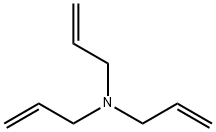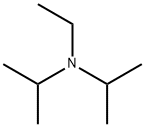Diallylamine
Synonym(s):Diallylamine;N-2-Propenyl-2-propen-1-amine
- CAS NO.:124-02-7
- Empirical Formula: C6H11N
- Molecular Weight: 97.16
- MDL number: MFCD00008642
- EINECS: 204-671-2
- SAFETY DATA SHEET (SDS)
- Update Date: 2024-12-18 14:15:32

What is Diallylamine?
Chemical properties
Diallylamine is a clear colourless to yellow flammable liquid. Soluble in water, alcohol, ether, benzene, with ammonia smell. It can be detected, but it is not unpleasant at 2-9 ppm and is not intolerable at 70 ppm.
The Uses of Diallylamine
Diallylamine is used as a solvent and in organic synthesis, including crop protection, an auxiliary in paper making, ionic water purifier, polymer monomer, pharmaceutical intermediate, etc. It is also used in the production of N,N-diallyldimethylammonium chloride and N,N-diallyldichloroacetamide, which is used as a safener in the preemergence herbicide EPTC (S-ethyl dipropylthiocarbamate).
Preparation
Diallylamine is synthesized by hydrolysis of diallyl cyanamide. The hydrolysis reaction was carried out in a sulfuric acid medium, and the reflux was moderated for 6h. Yield 80-88%.
General Description
A liquid with a disagreeable odor. Less dense than water. Flash point 70°F. May be toxic by inhalation and skin absorption. Irritates skin and eyes. Used to make other chemicals.
Air & Water Reactions
Highly flammable. Soluble in water.
Reactivity Profile
Diallylamine neutralizes acids in exothermic reactions to form salts plus water. May be incompatible with isocyanates, halogenated organics, peroxides, phenols (acidic), epoxides, anhydrides, and acid halides. Flammable gaseous hydrogen may be generated in combination with strong reducing agents, such as hydrides.
Health Hazard
May cause toxic effects if inhaled or ingested/swallowed. Contact with substance may cause severe burns to skin and eyes. Fire will produce irritating, corrosive and/or toxic gases. Vapors may cause dizziness or suffocation. Runoff from fire control or dilution water may cause pollution.
Fire Hazard
Diallylamine is a flammable liquid and a dangerous fire hazard when exposed to heat or flame. Vapors may travel to a source of ignition and flash back, while containers may explode in the heat of a fire. The compound may present a vapor explosion hazard indoors, outdoors, or in sewers. When heated to decomposition, diallylamine emits toxic fumes of NOx (Lewis, 1992).
Safety Profile
Poison by ingestion, skin contact, and intraperitoneal routes. Moderately toxic by inhalation. Human systemic effects by inhalation route: eye lachrymation and changes in the trachea or bronchi. A skin and severe eye irritant. A dangerous fire hazard when exposed to heat or flame. When heated to decomposition it emits toxic fumes of NOx. See also AMINES and ALLYL COMPOUNDS.
Toxicology
Diallylamine can cause myocardial degeneration as well as damage to the kidneys and liver. This has been observed in rats and rabbits. Allylamines cause a severe primary fibrosis of the myocardium, The oral application of allylamine in the drinking water over 81–104 days caused a dose-dependent myocardial degeneration in rats.
Purification Methods
Keep the amine over KOH pellets overnight, decant and distil it from a few pellets of KOH at atmospheric pressure (b 108-111o), then fractionate through a Vigreux column (p 11). [Vliet J Am Chem Soc 46 1307 1924, Org Synth Coll Vol 1 201 1941.] The hydrochloride has m 164-165o (from Me2CO/EtOH). [Butler & Angels J Am Chem Soc 79 3128 1957.]
Properties of Diallylamine
| Melting point: | -88 °C (lit.) |
| Boiling point: | 111-112 °C (lit.) |
| Density | 0.787 g/mL at 25 °C (lit.) |
| vapor density | 3.35 (vs air) |
| vapor pressure | 18 mm Hg ( 20 °C) |
| refractive index | n |
| Flash point: | 60 °F |
| storage temp. | Store below +30°C. |
| solubility | 86g/l |
| form | Liquid |
| pka | pK1:9.29(+1) (25°C,μ=0.02) |
| color | Clear colorless to yellow |
| PH | 11.5 (9.7g/l, H2O) |
| Odor | ammonia-like odor |
| explosive limit | 0.93-14.2%(V) |
| Water Solubility | 8.6 g/100mL |
| Sensitive | Air Sensitive |
| Merck | 14,2971 |
| BRN | 773718 |
| Dielectric constant | 3.7799999999999998 |
| CAS DataBase Reference | 124-02-7(CAS DataBase Reference) |
| NIST Chemistry Reference | 2-Propen-1-amine, N-2-propenyl-(124-02-7) |
| EPA Substance Registry System | Diallylamine (124-02-7) |
Safety information for Diallylamine
| Signal word | Danger |
| Pictogram(s) |
 Flame Flammables GHS02  Corrosion Corrosives GHS05  Skull and Crossbones Acute Toxicity GHS06 |
| GHS Hazard Statements |
H225:Flammable liquids H311:Acute toxicity,dermal H314:Skin corrosion/irritation |
| Precautionary Statement Codes |
P210:Keep away from heat/sparks/open flames/hot surfaces. — No smoking. P280:Wear protective gloves/protective clothing/eye protection/face protection. P301+P312:IF SWALLOWED: call a POISON CENTER or doctor/physician IF you feel unwell. P303+P361+P353:IF ON SKIN (or hair): Remove/Take off Immediately all contaminated clothing. Rinse SKIN with water/shower. P305+P351+P338:IF IN EYES: Rinse cautiously with water for several minutes. Remove contact lenses, if present and easy to do. Continuerinsing. |
Computed Descriptors for Diallylamine
New Products
Tert-butyl bis(2-chloroethyl)carbamate (S)-3-Aminobutanenitrile hydrochloride N-Boc-D-alaninol N-BOC-D/L-ALANINOL N-octanoyl benzotriazole 4-Hydrazinobenzoic acid 3,4-Dibenzyloxybenzaldehyde 3-Nitrobenzaldehyde 1,1’-CARBONYLDIIMIDAZOLE R-2-BENZYLOXY PROPIONIC ACID 1,1’-CARBONYLDI (1,2-4 TRIAZOLE) 4-HYDROXY BENZYL ALCOHOL 3-NITRO-2-METHYL ANILINE (2-Hydroxyphenyl)acetonitrile 5-BROMO-2CYANO PYRIDINE 5,6-Dimethoxyindanone 5-broMo-2-chloro-N-cyclopentylpyriMidin-4-aMine 2-(Cyanocyclohexyl)acetic acid 4-methoxy-3,5-dinitropyridine 2-aminopropyl benzoate hydrochloride 1-(4-(aminomethyl)benzyl)urea hydrochloride tert-butyl 4- (ureidomethyl)benzylcarbamate diethyl 2-(2-((tertbutoxycarbonyl)amino) ethyl)malonate Ethyl-2-chloro((4-methoxyphenyl)hydrazono)acetateRelated products of tetrahydrofuran








You may like
-
 124-02-7 Diallylamine, 99% 99%View Details
124-02-7 Diallylamine, 99% 99%View Details
124-02-7 -
 Diallylamine CAS 124-02-7View Details
Diallylamine CAS 124-02-7View Details
124-02-7 -
 Diallylamine CAS 124-02-7View Details
Diallylamine CAS 124-02-7View Details
124-02-7 -
 Diallylamine CAS 124-02-7View Details
Diallylamine CAS 124-02-7View Details
124-02-7 -
 Diallylamine CAS 124-02-7View Details
Diallylamine CAS 124-02-7View Details
124-02-7 -
 N-Vinylformamide 99%View Details
N-Vinylformamide 99%View Details
13162-05-5 -
 2-ethyl-6-methyl-3-hydroxypyridine succinate 99%View Details
2-ethyl-6-methyl-3-hydroxypyridine succinate 99%View Details
127464-43-1 -
 2-ETHYLPYRIDINE 100-71-0 99%View Details
2-ETHYLPYRIDINE 100-71-0 99%View Details
100-71-0